MGT302 Strategic Management Assessment: Approaches and Analysis Report
VerifiedAdded on 2022/08/24
|16
|3199
|24
Report
AI Summary
This report provides a comprehensive analysis of three key approaches to strategic management: the sustainable approach, the stakeholder approach, and dynamic capabilities. It begins with an executive summary and table of contents, followed by an introduction to strategic management. The core of the report delves into each approach, detailing its history, suggested benefits, and limitations. The sustainable approach is examined in the context of Apple's practices. The stakeholder approach is discussed in relation to Walmart's strategies. The report concludes by summarizing the key findings and implications of each strategic approach. Scholarly sources are used to support the analysis, ensuring the credibility of the arguments presented. The report follows the Harvard guidelines and includes a reference list.
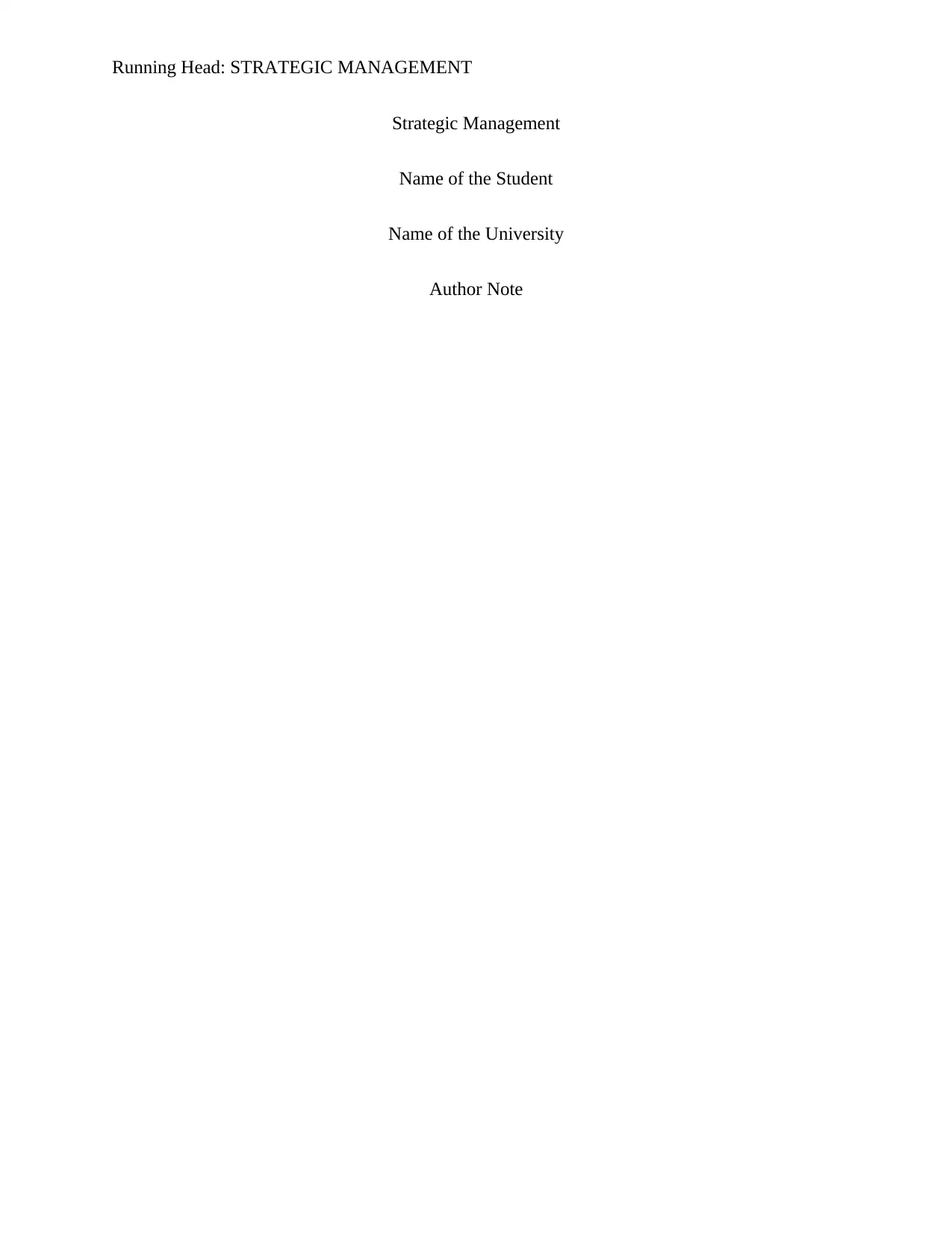
Running Head: STRATEGIC MANAGEMENT
Strategic Management
Name of the Student
Name of the University
Author Note
Strategic Management
Name of the Student
Name of the University
Author Note
Paraphrase This Document
Need a fresh take? Get an instant paraphrase of this document with our AI Paraphraser
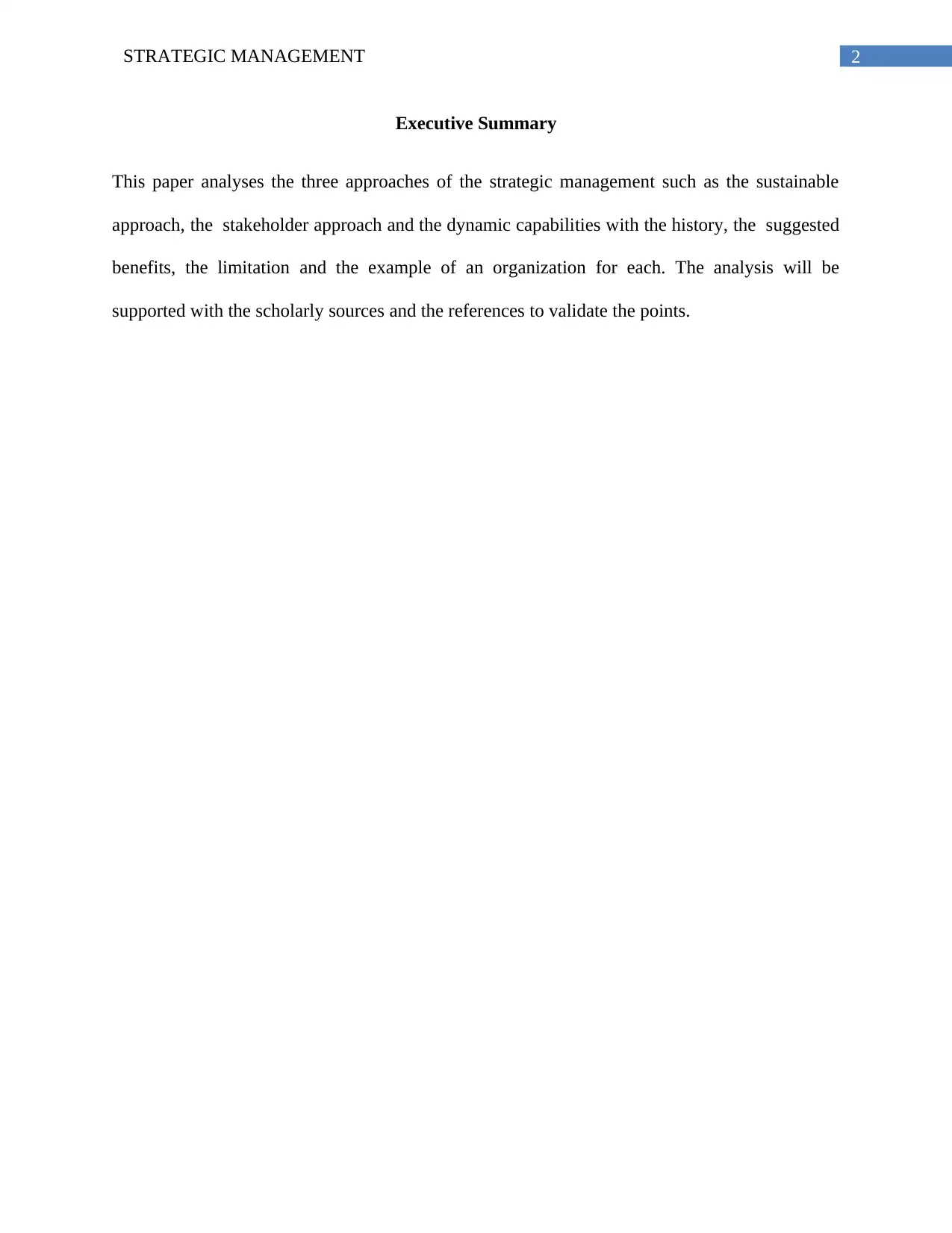
2STRATEGIC MANAGEMENT
Executive Summary
This paper analyses the three approaches of the strategic management such as the sustainable
approach, the stakeholder approach and the dynamic capabilities with the history, the suggested
benefits, the limitation and the example of an organization for each. The analysis will be
supported with the scholarly sources and the references to validate the points.
Executive Summary
This paper analyses the three approaches of the strategic management such as the sustainable
approach, the stakeholder approach and the dynamic capabilities with the history, the suggested
benefits, the limitation and the example of an organization for each. The analysis will be
supported with the scholarly sources and the references to validate the points.

3STRATEGIC MANAGEMENT
Table of Contents
Introduction......................................................................................................................................3
Discussion........................................................................................................................................3
Sustainable approach-..................................................................................................................3
Stakeholder approach-.................................................................................................................5
Dynamic Capabilities-.................................................................................................................8
Conclusion-....................................................................................................................................10
Table of Contents
Introduction......................................................................................................................................3
Discussion........................................................................................................................................3
Sustainable approach-..................................................................................................................3
Stakeholder approach-.................................................................................................................5
Dynamic Capabilities-.................................................................................................................8
Conclusion-....................................................................................................................................10
⊘ This is a preview!⊘
Do you want full access?
Subscribe today to unlock all pages.

Trusted by 1+ million students worldwide
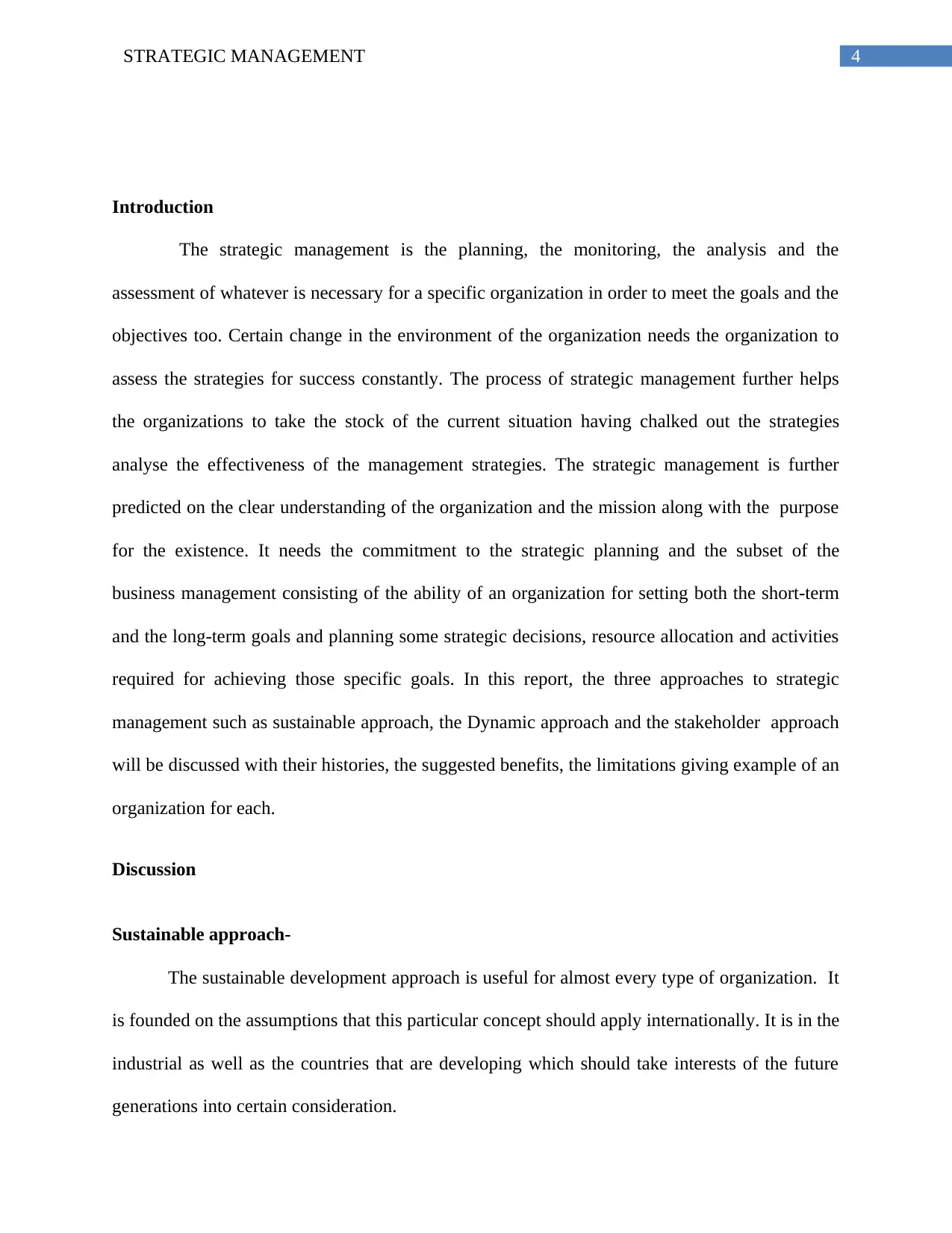
4STRATEGIC MANAGEMENT
Introduction
The strategic management is the planning, the monitoring, the analysis and the
assessment of whatever is necessary for a specific organization in order to meet the goals and the
objectives too. Certain change in the environment of the organization needs the organization to
assess the strategies for success constantly. The process of strategic management further helps
the organizations to take the stock of the current situation having chalked out the strategies
analyse the effectiveness of the management strategies. The strategic management is further
predicted on the clear understanding of the organization and the mission along with the purpose
for the existence. It needs the commitment to the strategic planning and the subset of the
business management consisting of the ability of an organization for setting both the short-term
and the long-term goals and planning some strategic decisions, resource allocation and activities
required for achieving those specific goals. In this report, the three approaches to strategic
management such as sustainable approach, the Dynamic approach and the stakeholder approach
will be discussed with their histories, the suggested benefits, the limitations giving example of an
organization for each.
Discussion
Sustainable approach-
The sustainable development approach is useful for almost every type of organization. It
is founded on the assumptions that this particular concept should apply internationally. It is in the
industrial as well as the countries that are developing which should take interests of the future
generations into certain consideration.
Introduction
The strategic management is the planning, the monitoring, the analysis and the
assessment of whatever is necessary for a specific organization in order to meet the goals and the
objectives too. Certain change in the environment of the organization needs the organization to
assess the strategies for success constantly. The process of strategic management further helps
the organizations to take the stock of the current situation having chalked out the strategies
analyse the effectiveness of the management strategies. The strategic management is further
predicted on the clear understanding of the organization and the mission along with the purpose
for the existence. It needs the commitment to the strategic planning and the subset of the
business management consisting of the ability of an organization for setting both the short-term
and the long-term goals and planning some strategic decisions, resource allocation and activities
required for achieving those specific goals. In this report, the three approaches to strategic
management such as sustainable approach, the Dynamic approach and the stakeholder approach
will be discussed with their histories, the suggested benefits, the limitations giving example of an
organization for each.
Discussion
Sustainable approach-
The sustainable development approach is useful for almost every type of organization. It
is founded on the assumptions that this particular concept should apply internationally. It is in the
industrial as well as the countries that are developing which should take interests of the future
generations into certain consideration.
Paraphrase This Document
Need a fresh take? Get an instant paraphrase of this document with our AI Paraphraser

5STRATEGIC MANAGEMENT
History- The sustainability concept can be well traced back to the 18th/19th century Germany.
The concept has evolved since the response to the devastating effects of the forest exploitation
with the view of upholding a particular timber supply that preserves the functions of the forest
(Bendell 2017).
Suggested benefits- There are many benefits of the sustainable approach such as having
improvement in brand image and the competitive advantage, increasing the productivity having
reduced the costs, increased business ability for complying with the regulations, attracting
investors and the employee, reducing the waste and making the shareholders content (Ritala et
al., 2018).
Limitation- This particular approach is quite time –consuming and costly needing a team behind
the implementation. When the example of the islands is concerned, there is no such disposal fee
for the wastes that are non-hazardous. Moreover, the sustainability is not limited to only the
environmental problems, there are many organizations too that focus on the environmental
aspect having damaged the economic and the social part (Joyce and Paquin 2016). The
sustainability is not an easy part to be applied in the optimization. The decision makers of the
company can easily deal with the simple metrics as the carbon footprints but the sustainability
logic that is process-oriented would be a huge hurdle specifically for the smaller firms and also
for those who are not close to the end-use (Dyllick and Muff 2016). Sustainability has to be
quite legislated for becoming a part of the entire business. The sustainability has still not become
an integrated part of the organizations due to the type of process which is being properly carried
out. It is further found that most of the pharma, the chemical and the manufacturing units
concentrate on the safety and the focus on the safety and the health with few other policies that
are not diversified in terms of the ethic (Cubas‐Díaz and Martinez Sedano 2018).
History- The sustainability concept can be well traced back to the 18th/19th century Germany.
The concept has evolved since the response to the devastating effects of the forest exploitation
with the view of upholding a particular timber supply that preserves the functions of the forest
(Bendell 2017).
Suggested benefits- There are many benefits of the sustainable approach such as having
improvement in brand image and the competitive advantage, increasing the productivity having
reduced the costs, increased business ability for complying with the regulations, attracting
investors and the employee, reducing the waste and making the shareholders content (Ritala et
al., 2018).
Limitation- This particular approach is quite time –consuming and costly needing a team behind
the implementation. When the example of the islands is concerned, there is no such disposal fee
for the wastes that are non-hazardous. Moreover, the sustainability is not limited to only the
environmental problems, there are many organizations too that focus on the environmental
aspect having damaged the economic and the social part (Joyce and Paquin 2016). The
sustainability is not an easy part to be applied in the optimization. The decision makers of the
company can easily deal with the simple metrics as the carbon footprints but the sustainability
logic that is process-oriented would be a huge hurdle specifically for the smaller firms and also
for those who are not close to the end-use (Dyllick and Muff 2016). Sustainability has to be
quite legislated for becoming a part of the entire business. The sustainability has still not become
an integrated part of the organizations due to the type of process which is being properly carried
out. It is further found that most of the pharma, the chemical and the manufacturing units
concentrate on the safety and the focus on the safety and the health with few other policies that
are not diversified in terms of the ethic (Cubas‐Díaz and Martinez Sedano 2018).
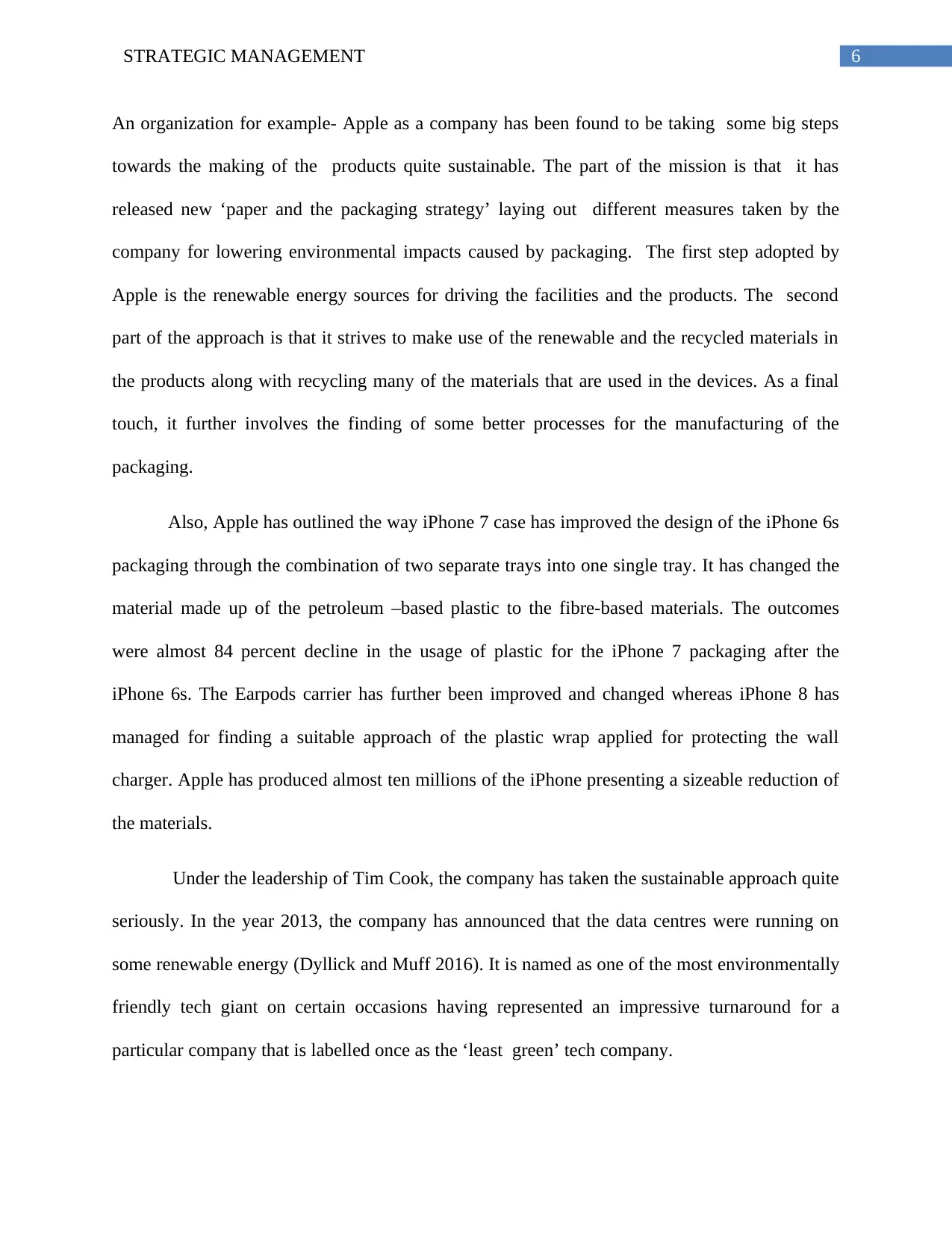
6STRATEGIC MANAGEMENT
An organization for example- Apple as a company has been found to be taking some big steps
towards the making of the products quite sustainable. The part of the mission is that it has
released new ‘paper and the packaging strategy’ laying out different measures taken by the
company for lowering environmental impacts caused by packaging. The first step adopted by
Apple is the renewable energy sources for driving the facilities and the products. The second
part of the approach is that it strives to make use of the renewable and the recycled materials in
the products along with recycling many of the materials that are used in the devices. As a final
touch, it further involves the finding of some better processes for the manufacturing of the
packaging.
Also, Apple has outlined the way iPhone 7 case has improved the design of the iPhone 6s
packaging through the combination of two separate trays into one single tray. It has changed the
material made up of the petroleum –based plastic to the fibre-based materials. The outcomes
were almost 84 percent decline in the usage of plastic for the iPhone 7 packaging after the
iPhone 6s. The Earpods carrier has further been improved and changed whereas iPhone 8 has
managed for finding a suitable approach of the plastic wrap applied for protecting the wall
charger. Apple has produced almost ten millions of the iPhone presenting a sizeable reduction of
the materials.
Under the leadership of Tim Cook, the company has taken the sustainable approach quite
seriously. In the year 2013, the company has announced that the data centres were running on
some renewable energy (Dyllick and Muff 2016). It is named as one of the most environmentally
friendly tech giant on certain occasions having represented an impressive turnaround for a
particular company that is labelled once as the ‘least green’ tech company.
An organization for example- Apple as a company has been found to be taking some big steps
towards the making of the products quite sustainable. The part of the mission is that it has
released new ‘paper and the packaging strategy’ laying out different measures taken by the
company for lowering environmental impacts caused by packaging. The first step adopted by
Apple is the renewable energy sources for driving the facilities and the products. The second
part of the approach is that it strives to make use of the renewable and the recycled materials in
the products along with recycling many of the materials that are used in the devices. As a final
touch, it further involves the finding of some better processes for the manufacturing of the
packaging.
Also, Apple has outlined the way iPhone 7 case has improved the design of the iPhone 6s
packaging through the combination of two separate trays into one single tray. It has changed the
material made up of the petroleum –based plastic to the fibre-based materials. The outcomes
were almost 84 percent decline in the usage of plastic for the iPhone 7 packaging after the
iPhone 6s. The Earpods carrier has further been improved and changed whereas iPhone 8 has
managed for finding a suitable approach of the plastic wrap applied for protecting the wall
charger. Apple has produced almost ten millions of the iPhone presenting a sizeable reduction of
the materials.
Under the leadership of Tim Cook, the company has taken the sustainable approach quite
seriously. In the year 2013, the company has announced that the data centres were running on
some renewable energy (Dyllick and Muff 2016). It is named as one of the most environmentally
friendly tech giant on certain occasions having represented an impressive turnaround for a
particular company that is labelled once as the ‘least green’ tech company.
⊘ This is a preview!⊘
Do you want full access?
Subscribe today to unlock all pages.

Trusted by 1+ million students worldwide
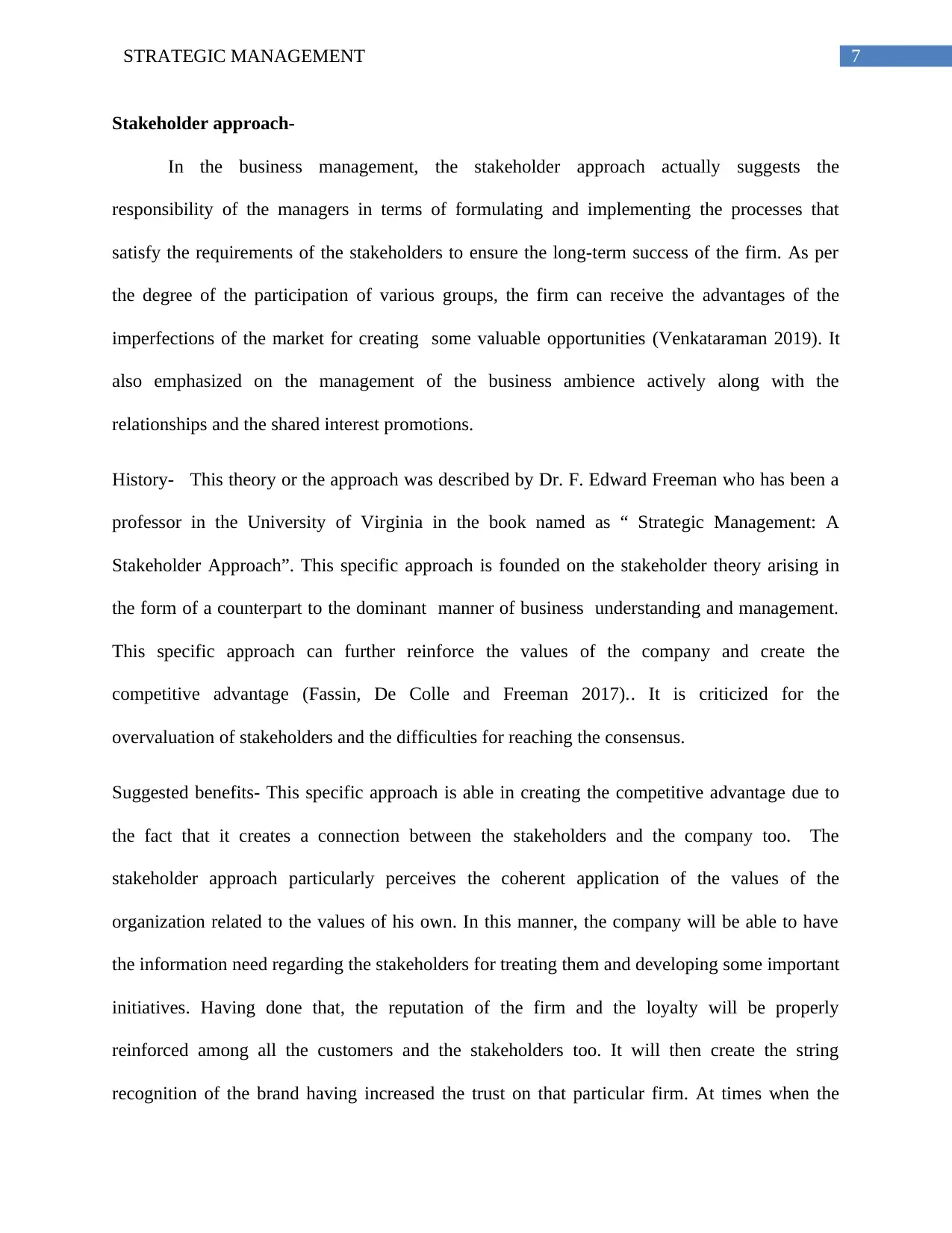
7STRATEGIC MANAGEMENT
Stakeholder approach-
In the business management, the stakeholder approach actually suggests the
responsibility of the managers in terms of formulating and implementing the processes that
satisfy the requirements of the stakeholders to ensure the long-term success of the firm. As per
the degree of the participation of various groups, the firm can receive the advantages of the
imperfections of the market for creating some valuable opportunities (Venkataraman 2019). It
also emphasized on the management of the business ambience actively along with the
relationships and the shared interest promotions.
History- This theory or the approach was described by Dr. F. Edward Freeman who has been a
professor in the University of Virginia in the book named as “ Strategic Management: A
Stakeholder Approach”. This specific approach is founded on the stakeholder theory arising in
the form of a counterpart to the dominant manner of business understanding and management.
This specific approach can further reinforce the values of the company and create the
competitive advantage (Fassin, De Colle and Freeman 2017).. It is criticized for the
overvaluation of stakeholders and the difficulties for reaching the consensus.
Suggested benefits- This specific approach is able in creating the competitive advantage due to
the fact that it creates a connection between the stakeholders and the company too. The
stakeholder approach particularly perceives the coherent application of the values of the
organization related to the values of his own. In this manner, the company will be able to have
the information need regarding the stakeholders for treating them and developing some important
initiatives. Having done that, the reputation of the firm and the loyalty will be properly
reinforced among all the customers and the stakeholders too. It will then create the string
recognition of the brand having increased the trust on that particular firm. At times when the
Stakeholder approach-
In the business management, the stakeholder approach actually suggests the
responsibility of the managers in terms of formulating and implementing the processes that
satisfy the requirements of the stakeholders to ensure the long-term success of the firm. As per
the degree of the participation of various groups, the firm can receive the advantages of the
imperfections of the market for creating some valuable opportunities (Venkataraman 2019). It
also emphasized on the management of the business ambience actively along with the
relationships and the shared interest promotions.
History- This theory or the approach was described by Dr. F. Edward Freeman who has been a
professor in the University of Virginia in the book named as “ Strategic Management: A
Stakeholder Approach”. This specific approach is founded on the stakeholder theory arising in
the form of a counterpart to the dominant manner of business understanding and management.
This specific approach can further reinforce the values of the company and create the
competitive advantage (Fassin, De Colle and Freeman 2017).. It is criticized for the
overvaluation of stakeholders and the difficulties for reaching the consensus.
Suggested benefits- This specific approach is able in creating the competitive advantage due to
the fact that it creates a connection between the stakeholders and the company too. The
stakeholder approach particularly perceives the coherent application of the values of the
organization related to the values of his own. In this manner, the company will be able to have
the information need regarding the stakeholders for treating them and developing some important
initiatives. Having done that, the reputation of the firm and the loyalty will be properly
reinforced among all the customers and the stakeholders too. It will then create the string
recognition of the brand having increased the trust on that particular firm. At times when the
Paraphrase This Document
Need a fresh take? Get an instant paraphrase of this document with our AI Paraphraser
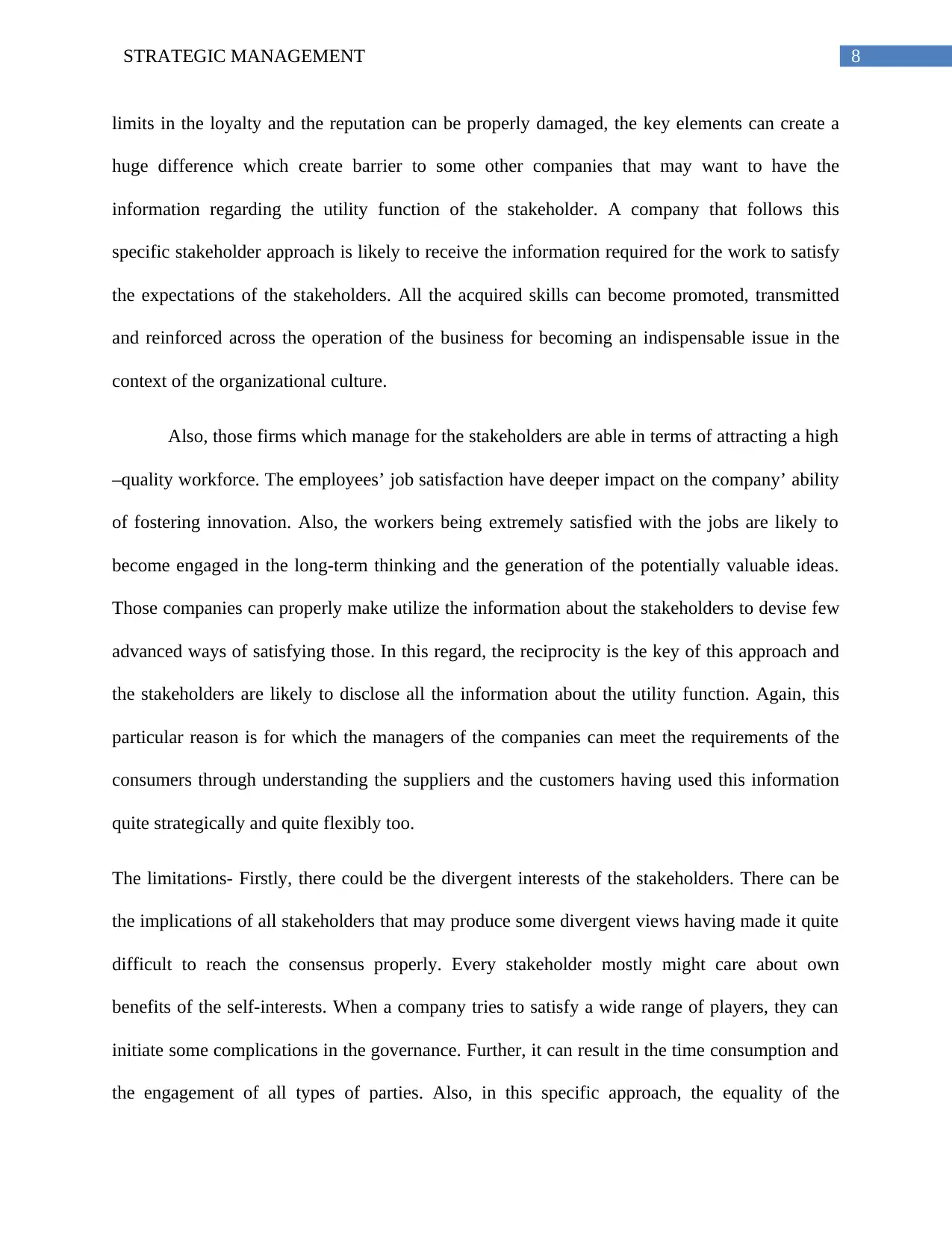
8STRATEGIC MANAGEMENT
limits in the loyalty and the reputation can be properly damaged, the key elements can create a
huge difference which create barrier to some other companies that may want to have the
information regarding the utility function of the stakeholder. A company that follows this
specific stakeholder approach is likely to receive the information required for the work to satisfy
the expectations of the stakeholders. All the acquired skills can become promoted, transmitted
and reinforced across the operation of the business for becoming an indispensable issue in the
context of the organizational culture.
Also, those firms which manage for the stakeholders are able in terms of attracting a high
–quality workforce. The employees’ job satisfaction have deeper impact on the company’ ability
of fostering innovation. Also, the workers being extremely satisfied with the jobs are likely to
become engaged in the long-term thinking and the generation of the potentially valuable ideas.
Those companies can properly make utilize the information about the stakeholders to devise few
advanced ways of satisfying those. In this regard, the reciprocity is the key of this approach and
the stakeholders are likely to disclose all the information about the utility function. Again, this
particular reason is for which the managers of the companies can meet the requirements of the
consumers through understanding the suppliers and the customers having used this information
quite strategically and quite flexibly too.
The limitations- Firstly, there could be the divergent interests of the stakeholders. There can be
the implications of all stakeholders that may produce some divergent views having made it quite
difficult to reach the consensus properly. Every stakeholder mostly might care about own
benefits of the self-interests. When a company tries to satisfy a wide range of players, they can
initiate some complications in the governance. Further, it can result in the time consumption and
the engagement of all types of parties. Also, in this specific approach, the equality of the
limits in the loyalty and the reputation can be properly damaged, the key elements can create a
huge difference which create barrier to some other companies that may want to have the
information regarding the utility function of the stakeholder. A company that follows this
specific stakeholder approach is likely to receive the information required for the work to satisfy
the expectations of the stakeholders. All the acquired skills can become promoted, transmitted
and reinforced across the operation of the business for becoming an indispensable issue in the
context of the organizational culture.
Also, those firms which manage for the stakeholders are able in terms of attracting a high
–quality workforce. The employees’ job satisfaction have deeper impact on the company’ ability
of fostering innovation. Also, the workers being extremely satisfied with the jobs are likely to
become engaged in the long-term thinking and the generation of the potentially valuable ideas.
Those companies can properly make utilize the information about the stakeholders to devise few
advanced ways of satisfying those. In this regard, the reciprocity is the key of this approach and
the stakeholders are likely to disclose all the information about the utility function. Again, this
particular reason is for which the managers of the companies can meet the requirements of the
consumers through understanding the suppliers and the customers having used this information
quite strategically and quite flexibly too.
The limitations- Firstly, there could be the divergent interests of the stakeholders. There can be
the implications of all stakeholders that may produce some divergent views having made it quite
difficult to reach the consensus properly. Every stakeholder mostly might care about own
benefits of the self-interests. When a company tries to satisfy a wide range of players, they can
initiate some complications in the governance. Further, it can result in the time consumption and
the engagement of all types of parties. Also, in this specific approach, the equality of the
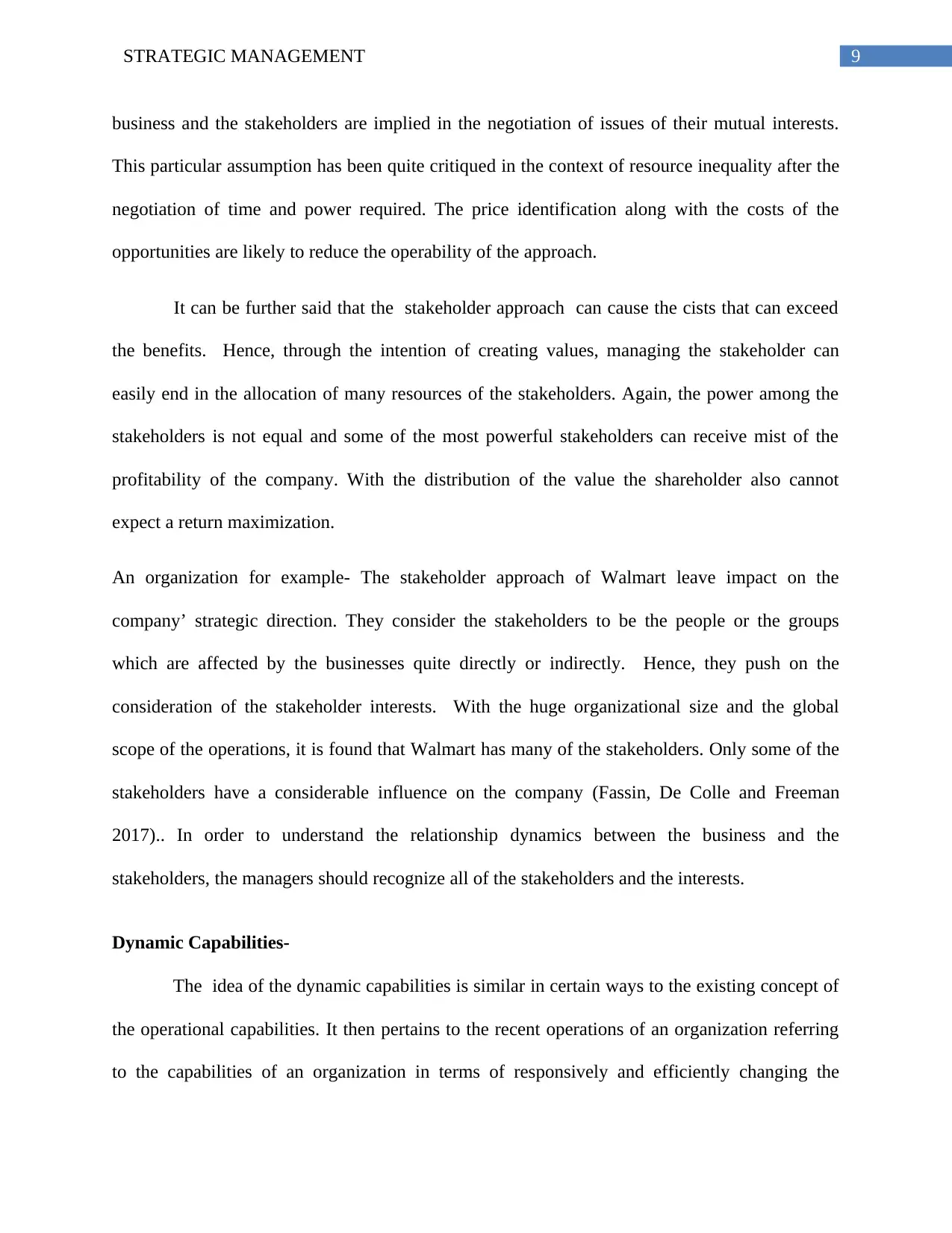
9STRATEGIC MANAGEMENT
business and the stakeholders are implied in the negotiation of issues of their mutual interests.
This particular assumption has been quite critiqued in the context of resource inequality after the
negotiation of time and power required. The price identification along with the costs of the
opportunities are likely to reduce the operability of the approach.
It can be further said that the stakeholder approach can cause the cists that can exceed
the benefits. Hence, through the intention of creating values, managing the stakeholder can
easily end in the allocation of many resources of the stakeholders. Again, the power among the
stakeholders is not equal and some of the most powerful stakeholders can receive mist of the
profitability of the company. With the distribution of the value the shareholder also cannot
expect a return maximization.
An organization for example- The stakeholder approach of Walmart leave impact on the
company’ strategic direction. They consider the stakeholders to be the people or the groups
which are affected by the businesses quite directly or indirectly. Hence, they push on the
consideration of the stakeholder interests. With the huge organizational size and the global
scope of the operations, it is found that Walmart has many of the stakeholders. Only some of the
stakeholders have a considerable influence on the company (Fassin, De Colle and Freeman
2017).. In order to understand the relationship dynamics between the business and the
stakeholders, the managers should recognize all of the stakeholders and the interests.
Dynamic Capabilities-
The idea of the dynamic capabilities is similar in certain ways to the existing concept of
the operational capabilities. It then pertains to the recent operations of an organization referring
to the capabilities of an organization in terms of responsively and efficiently changing the
business and the stakeholders are implied in the negotiation of issues of their mutual interests.
This particular assumption has been quite critiqued in the context of resource inequality after the
negotiation of time and power required. The price identification along with the costs of the
opportunities are likely to reduce the operability of the approach.
It can be further said that the stakeholder approach can cause the cists that can exceed
the benefits. Hence, through the intention of creating values, managing the stakeholder can
easily end in the allocation of many resources of the stakeholders. Again, the power among the
stakeholders is not equal and some of the most powerful stakeholders can receive mist of the
profitability of the company. With the distribution of the value the shareholder also cannot
expect a return maximization.
An organization for example- The stakeholder approach of Walmart leave impact on the
company’ strategic direction. They consider the stakeholders to be the people or the groups
which are affected by the businesses quite directly or indirectly. Hence, they push on the
consideration of the stakeholder interests. With the huge organizational size and the global
scope of the operations, it is found that Walmart has many of the stakeholders. Only some of the
stakeholders have a considerable influence on the company (Fassin, De Colle and Freeman
2017).. In order to understand the relationship dynamics between the business and the
stakeholders, the managers should recognize all of the stakeholders and the interests.
Dynamic Capabilities-
The idea of the dynamic capabilities is similar in certain ways to the existing concept of
the operational capabilities. It then pertains to the recent operations of an organization referring
to the capabilities of an organization in terms of responsively and efficiently changing the
⊘ This is a preview!⊘
Do you want full access?
Subscribe today to unlock all pages.

Trusted by 1+ million students worldwide

10STRATEGIC MANAGEMENT
operations and developing the resources. The primary assumptions of this exact framework is
that the fundamental competencies of a company must be used for creating short-term
competitive positions which can be developed in the long -term competitive advantage. The
dynamic capability view concentrates on the issues of the competitive survival as a response to
the changing contemporary conditions of business (Girod, and Whittington 2017). The dynamic
capabilities help in the building of the industries for making this concept quite useful for the
senior managers who have set directions for the companies. It focuses on the development of the
strategies for the senior managers of the successful companies in terms of adapting to some
radical change during maintaining the standards of capability.
History- In terms of the strategic management, the dynamic capability is actually the capability
of a specific organization for purposefully adapting the resource base of a firm. This concept was
defined by Gary Pisano, David Teece and Amy Shuen in the paper named Dynamic Capabilities
and Strategic Management of the year 1997since the ability of the company is to integrate,
reconfigure and build the external and the internal abilities for addressing rapidly the changing
environment (Teece, Peteraf and Leih 2016).
Suggested benefits- It is actually the inherent capability of the company for purposefully and
optimally adapt the resource base of the organization. It helps in the formulation of ways of
strategic management and also the planning of the company’ strategy that helps in gaining of
competitive advantage. The management usually concentrates on the internal strengths of the
firm as the workforce along with the capital investments better than harping on some external
forces as the policies of the government and market trends (Birkinshaw, Zimmermann and
Raisch 2016). It is about sustaining the dynamic nature of the whole market for gaining the
competitive advantage. The firm can expand the business operations having followed the
operations and developing the resources. The primary assumptions of this exact framework is
that the fundamental competencies of a company must be used for creating short-term
competitive positions which can be developed in the long -term competitive advantage. The
dynamic capability view concentrates on the issues of the competitive survival as a response to
the changing contemporary conditions of business (Girod, and Whittington 2017). The dynamic
capabilities help in the building of the industries for making this concept quite useful for the
senior managers who have set directions for the companies. It focuses on the development of the
strategies for the senior managers of the successful companies in terms of adapting to some
radical change during maintaining the standards of capability.
History- In terms of the strategic management, the dynamic capability is actually the capability
of a specific organization for purposefully adapting the resource base of a firm. This concept was
defined by Gary Pisano, David Teece and Amy Shuen in the paper named Dynamic Capabilities
and Strategic Management of the year 1997since the ability of the company is to integrate,
reconfigure and build the external and the internal abilities for addressing rapidly the changing
environment (Teece, Peteraf and Leih 2016).
Suggested benefits- It is actually the inherent capability of the company for purposefully and
optimally adapt the resource base of the organization. It helps in the formulation of ways of
strategic management and also the planning of the company’ strategy that helps in gaining of
competitive advantage. The management usually concentrates on the internal strengths of the
firm as the workforce along with the capital investments better than harping on some external
forces as the policies of the government and market trends (Birkinshaw, Zimmermann and
Raisch 2016). It is about sustaining the dynamic nature of the whole market for gaining the
competitive advantage. The firm can expand the business operations having followed the
Paraphrase This Document
Need a fresh take? Get an instant paraphrase of this document with our AI Paraphraser
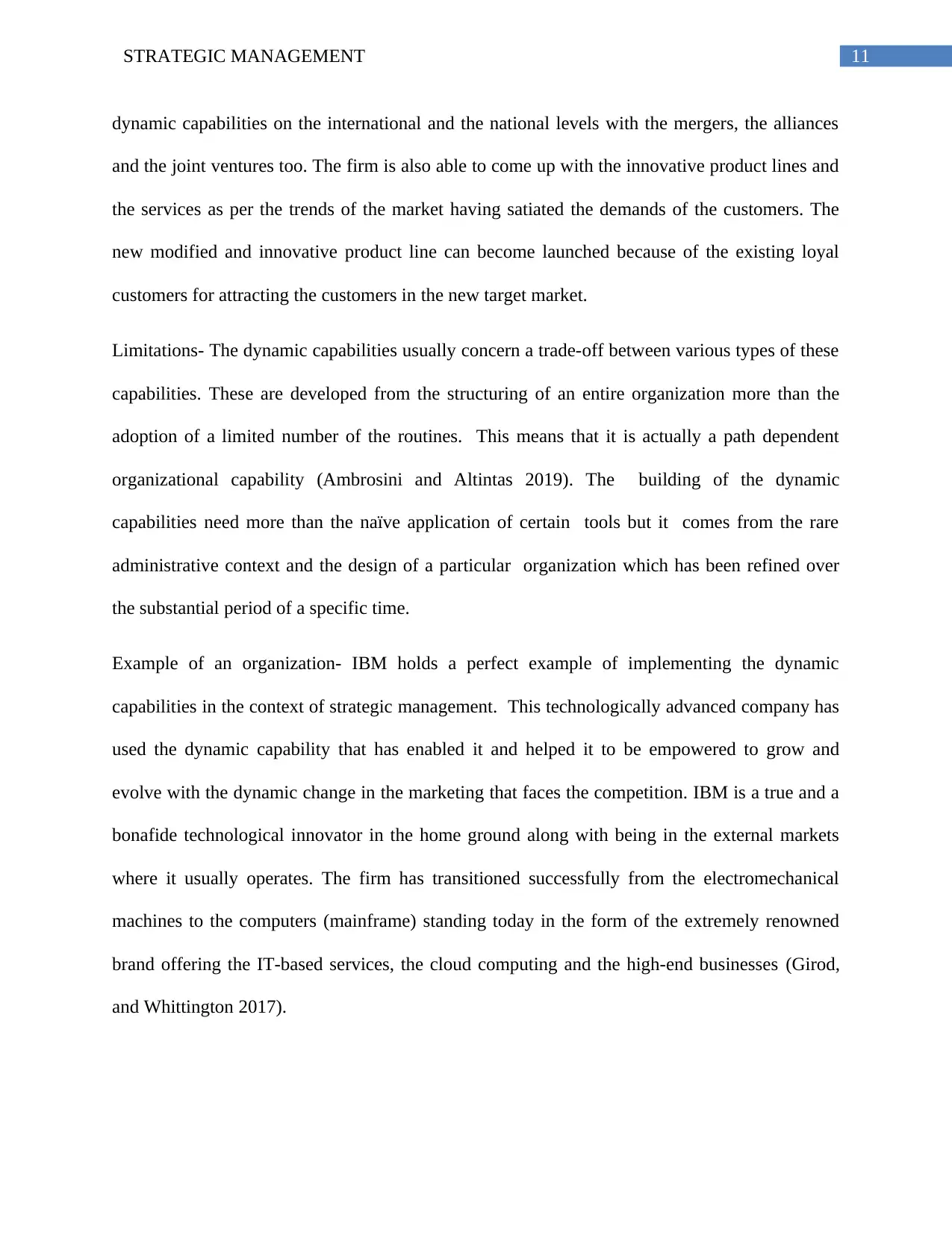
11STRATEGIC MANAGEMENT
dynamic capabilities on the international and the national levels with the mergers, the alliances
and the joint ventures too. The firm is also able to come up with the innovative product lines and
the services as per the trends of the market having satiated the demands of the customers. The
new modified and innovative product line can become launched because of the existing loyal
customers for attracting the customers in the new target market.
Limitations- The dynamic capabilities usually concern a trade-off between various types of these
capabilities. These are developed from the structuring of an entire organization more than the
adoption of a limited number of the routines. This means that it is actually a path dependent
organizational capability (Ambrosini and Altintas 2019). The building of the dynamic
capabilities need more than the naïve application of certain tools but it comes from the rare
administrative context and the design of a particular organization which has been refined over
the substantial period of a specific time.
Example of an organization- IBM holds a perfect example of implementing the dynamic
capabilities in the context of strategic management. This technologically advanced company has
used the dynamic capability that has enabled it and helped it to be empowered to grow and
evolve with the dynamic change in the marketing that faces the competition. IBM is a true and a
bonafide technological innovator in the home ground along with being in the external markets
where it usually operates. The firm has transitioned successfully from the electromechanical
machines to the computers (mainframe) standing today in the form of the extremely renowned
brand offering the IT-based services, the cloud computing and the high-end businesses (Girod,
and Whittington 2017).
dynamic capabilities on the international and the national levels with the mergers, the alliances
and the joint ventures too. The firm is also able to come up with the innovative product lines and
the services as per the trends of the market having satiated the demands of the customers. The
new modified and innovative product line can become launched because of the existing loyal
customers for attracting the customers in the new target market.
Limitations- The dynamic capabilities usually concern a trade-off between various types of these
capabilities. These are developed from the structuring of an entire organization more than the
adoption of a limited number of the routines. This means that it is actually a path dependent
organizational capability (Ambrosini and Altintas 2019). The building of the dynamic
capabilities need more than the naïve application of certain tools but it comes from the rare
administrative context and the design of a particular organization which has been refined over
the substantial period of a specific time.
Example of an organization- IBM holds a perfect example of implementing the dynamic
capabilities in the context of strategic management. This technologically advanced company has
used the dynamic capability that has enabled it and helped it to be empowered to grow and
evolve with the dynamic change in the marketing that faces the competition. IBM is a true and a
bonafide technological innovator in the home ground along with being in the external markets
where it usually operates. The firm has transitioned successfully from the electromechanical
machines to the computers (mainframe) standing today in the form of the extremely renowned
brand offering the IT-based services, the cloud computing and the high-end businesses (Girod,
and Whittington 2017).
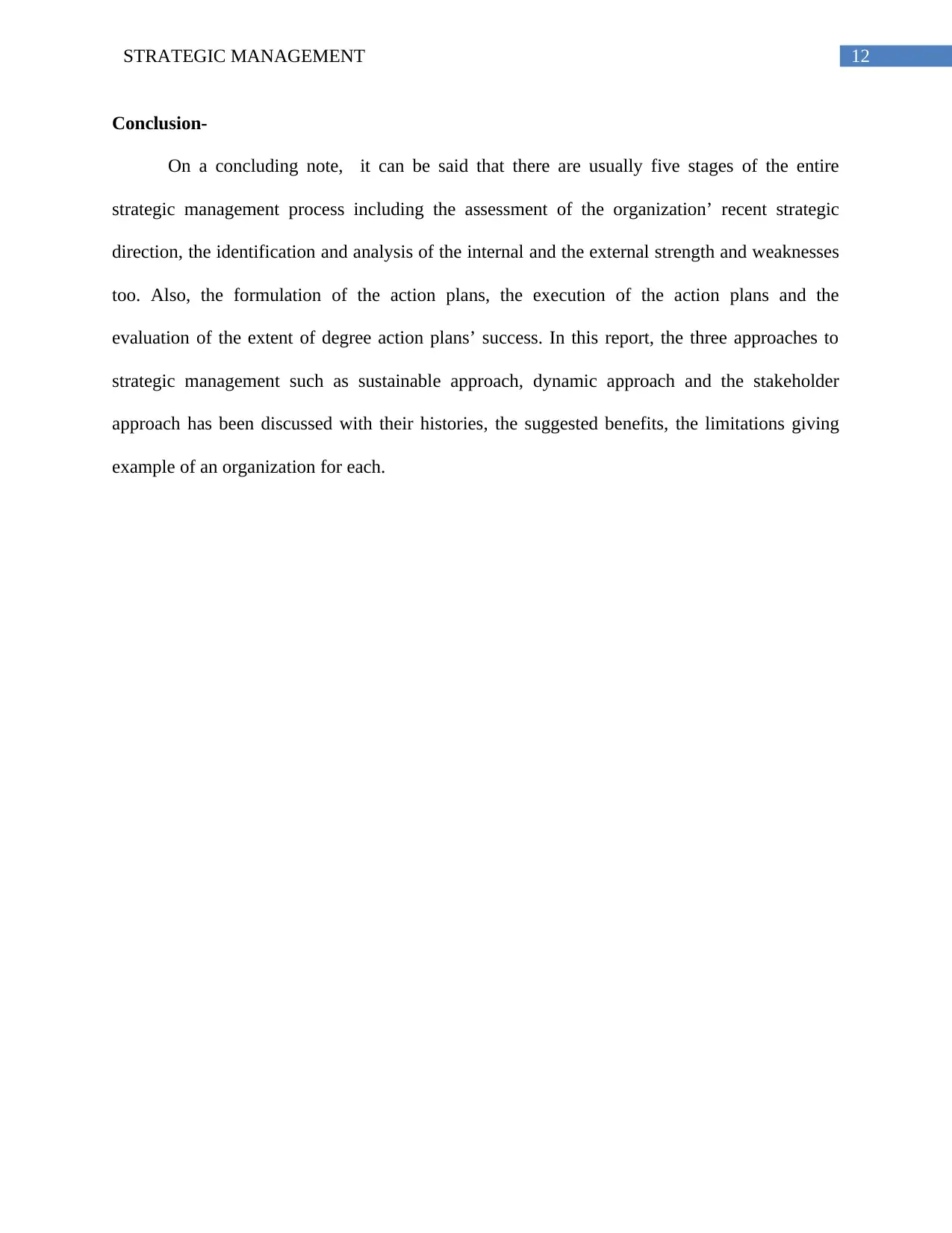
12STRATEGIC MANAGEMENT
Conclusion-
On a concluding note, it can be said that there are usually five stages of the entire
strategic management process including the assessment of the organization’ recent strategic
direction, the identification and analysis of the internal and the external strength and weaknesses
too. Also, the formulation of the action plans, the execution of the action plans and the
evaluation of the extent of degree action plans’ success. In this report, the three approaches to
strategic management such as sustainable approach, dynamic approach and the stakeholder
approach has been discussed with their histories, the suggested benefits, the limitations giving
example of an organization for each.
Conclusion-
On a concluding note, it can be said that there are usually five stages of the entire
strategic management process including the assessment of the organization’ recent strategic
direction, the identification and analysis of the internal and the external strength and weaknesses
too. Also, the formulation of the action plans, the execution of the action plans and the
evaluation of the extent of degree action plans’ success. In this report, the three approaches to
strategic management such as sustainable approach, dynamic approach and the stakeholder
approach has been discussed with their histories, the suggested benefits, the limitations giving
example of an organization for each.
⊘ This is a preview!⊘
Do you want full access?
Subscribe today to unlock all pages.

Trusted by 1+ million students worldwide
1 out of 16
Related Documents
Your All-in-One AI-Powered Toolkit for Academic Success.
+13062052269
info@desklib.com
Available 24*7 on WhatsApp / Email
![[object Object]](/_next/static/media/star-bottom.7253800d.svg)
Unlock your academic potential
Copyright © 2020–2025 A2Z Services. All Rights Reserved. Developed and managed by ZUCOL.





